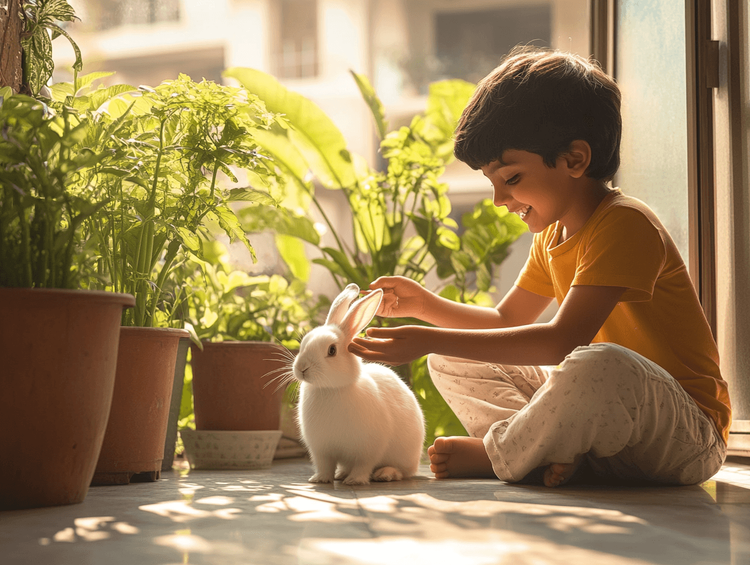Choosing the Right Pet as Your Best Friend

Table of Contents
- Why Dogs Make Great Companions for Kids
- Factors to Consider Before Choosing a Dog for Kids
- Best Dog Breeds for Kids
- Teaching Kids How to Interact With Dogs
- Training and Socialization: Essential for Harmony
- Why Children Should Learn to Express Emotions Through Writin
- Conclusion
- FAQs: Creative Writing and Kids
Pets bring immense joy, comfort, and unconditional love into our lives. They become our companions, confidants, and even silent therapists. Among the wide array of animals that people choose as pets, dogs hold a special place. Loyal, compassionate, and affectionate, they are often called a man’s best friend, and for all the right reasons.
In this blog, we’ll explore why a dog would be the ideal pet, from emotional companionship to daily routine and safety. Alongside, we’ll introduce you to PlanetSpark’s Creative Writing Course, a fun and skillful way to help children articulate such beautiful thoughts with structure, creativity, and confidence.
A Loyal Companion Like No Other
If I could have any animal as a pet, I would choose a dog without a second thought. Their loyalty is unmatched. They don’t just live in your house, they live in your heart. The emotional bond they form with their owners is strong and unwavering. Dogs have a sixth sense when it comes to understanding human emotions. They can sense when you’re sad, upset, or even simply lonely, and they rush to cheer you up in their little ways.
Unlike some other pets that are more independent, dogs thrive on human connection. This makes them the perfect emotional companion for both kids and adults. They nuzzle against you when you're low, wag their tails when you're happy, and curl up beside you at the end of a long day. The emotional security that dogs offer is both priceless and therapeutic.
This emotional connection also makes dogs a wonderful subject for young writers learning to explore feelings and relationships. PlanetSpark’s Creative Writing Course helps children tap into these deep, personal bonds through descriptive writing and narrative storytelling.
Every Breed Is Unique
One of the most exciting things about dogs is the sheer variety of breeds, each with distinct looks, personalities, and barks. According to the American Kennel Club, there are over 190 recognized dog breeds, each bred for specific purposes such as companionship, herding, guarding, or hunting. From a golden retriever’s gentleness to a beagle’s boundless energy or a German shepherd’s protectiveness, there’s a dog for every kind of household.
Despite their differences, one thing remains constant: their unconditional love for their owners. Many of my friends have different breeds of dogs, and it’s always heartwarming to see how each pet has adapted to its family’s vibe. Whether a cuddly Shih Tzu or an energetic Labrador, dogs blend into our lives like a new family member.
Understanding these breed differences not only makes dog ownership more informed but also offers a rich topic for research-based creative writing assignments. With PlanetSpark, children can enhance their ability to organize information, compare and contrast, and develop informative narratives about animals and human relationships.
Emotional Intelligence and Expression
One might think that dogs cannot communicate because they don’t speak our language, but they certainly do speak. Their language of love is so expressive that it needs no words. From their soulful eyes to their excited jumps, tail wags, and playful nudges, dogs are highly communicative.
Research in animal behavior has found that dogs use a complex mix of vocalizations, facial expressions, body postures, and even scent marking to communicate. They are capable of showing and understanding a wide range of emotions, including joy, fear, anger, jealousy, and sadness. Dogs have even been trained to detect emotional shifts in humans, and therapy dogs are increasingly being used in hospitals and schools to support mental well-being.
Living with a dog helps children and adults alike become more empathetic and emotionally aware. It also opens up opportunities to observe and describe emotions, which is a key part of effective storytelling. PlanetSpark’s Creative Writing Course nurtures this emotional literacy by teaching children how to write character-driven narratives that evoke real human feelings.

Constant Companionship
Dogs are always around when you need them, whether it’s a rainy day or a lonely evening. They are the kind of friends who never cancel plans, never argue, and never judge. When friends are busy or away, your dog will still be there wagging its tail, waiting to play or snuggle.
They bring routine and rhythm to your day, morning walks, meal times, play sessions, and grooming. This structure is great for kids, teaching them responsibility and empathy early on. The companionship of a dog is nurturing and stabilizing.
In a world where screen time often overshadows face-to-face interaction, dogs offer a real-world connection that stimulates physical activity, emotional bonding, and outdoor play. These are all wonderful experiences for children to write about in PlanetSpark’s guided writing prompts that encourage reflection and personal storytelling.
Safety and Security
While dogs are adorable and loving, they are also brave and protective. They are naturally alert and quick to sense danger, often becoming the first line of defense for a household. Their ability to guard your home and look out for you adds another layer of comfort.
Even smaller breeds tend to bark when strangers are around. Larger breeds are capable of physical protection if trained well. Dogs like Dobermans, Rottweilers, and German Shepherds are known for their protective instincts, making them ideal guard dogs. Police and military units also train dogs for search, rescue, and security tasks.
This duality of being both gentle and fierce is what makes dogs so special. It also allows for rich storytelling possibilities that mix action, drama, and emotion, something PlanetSpark students are encouraged to explore in fantasy and realistic fiction exercises.
Cognitive Abilities and Training
Dogs are also incredibly smart. Studies show that the average dog can understand up to 165 words and can count up to five. Some breeds, like Border Collies and Poodles, are known for their exceptional intelligence and learning capabilities. Dogs can be trained to perform complex tasks, follow multi-step instructions, and even detect diseases like cancer or predict epileptic seizures.
Teaching a dog commands like sit, stay, fetch, or roll over requires consistency and patience, qualities that children develop naturally through daily interactions. This makes dogs an effective tool for character building in young learners.
Writing about the training process, its challenges, funny moments, and successes gives children a sense of progression and achievement. In PlanetSpark’s curriculum, such experiences are transformed into compelling process essays and personal narratives.
Health Benefits of Owning a Dog
Having a dog is also scientifically proven to have numerous health benefits. Children who grow up with dogs tend to have stronger immune systems and are less likely to develop allergies. Dog owners are generally more physically active and have lower blood pressure and cholesterol levels. The simple act of petting a dog releases oxytocin, the 'feel good' hormone, which reduces stress and anxiety.
For kids, this translates to better mood regulation, reduced feelings of loneliness, and enhanced social interaction skills. Writing about these benefits not only promotes awareness but also supports persuasive writing and opinion-based essays, a focus area in PlanetSpark’s advanced modules.
Why Dogs Make Great Companions for Kids
Dogs are loyal, loving, and can be incredible friends to children. They offer emotional support, help reduce stress, and encourage outdoor activity. More than that, dogs can aid in the social and emotional development of children by teaching them patience, compassion, and accountability. Interacting with dogs has even been shown to improve children’s verbal skills and confidence.
Factors to Consider Before Choosing a Dog for Kids
Before bringing a dog home, consider these key factors:
1. Age of the Child
Children under 5 years may not yet understand how to gently handle a pet. Some dogs may be too fragile or reactive for younger children, making it essential to match the dog’s temperament with the child’s maturity level.
2. Size of the Dog
Large dogs may unintentionally knock down smaller kids, while very small dogs may be too delicate. Medium-sized, sturdy dogs are often ideal.
3. Temperament
Look for breeds known for their patience, friendliness, and adaptability. Dogs with a calm demeanor are better suited for busy households with kids.
4. Energy Level
Families with active children may enjoy high-energy dogs that love to play and run. In contrast, quieter households may prefer more laid-back breeds.
5. Grooming and Maintenance
Some dogs require regular grooming, while others have minimal upkeep. Consider your family's lifestyle and how much time you can dedicate to grooming.
Best Dog Breeds for Kids
1. Labrador Retriever
Labradors are affectionate, intelligent, and easy to train. They get along well with children and are known for their playful nature.
2. Golden Retriever
Golden Retrievers are gentle, loyal, and highly patient, making them excellent playmates for kids.
3. Beagle
Compact and friendly, Beagles love being part of a family. Their playful attitude and size make them a popular choice.
4. Cavalier King Charles Spaniel
This breed thrives on companionship and is naturally gentle, ideal for younger kids.
5. Poodle (Miniature or Standard)
Poodles are intelligent and hypoallergenic, which is great for families with allergies. They’re also highly trainable and fun-loving.
6. Bichon Frise
These fluffy white dogs are cheerful, low-shedding, and affectionate with kids.
7. Boxer
Boxers are loyal, energetic, and protective. They enjoy playing and are very patient with children.
Teaching Kids How to Interact With Dogs
No matter the breed, children should be taught how to properly approach, pet, and care for dogs. Establish rules like:
- Never disturb a dog while eating or sleeping
- Be gentle when petting
- Learn dog body language to understand their feelings
Responsible interaction builds trust and strengthens the bond between a child and their dog.
Training and Socialization: Essential for Harmony
Early training and socialization are crucial. Enrolling in obedience classes, exposing your dog to various environments, and involving kids in the training process will lead to a well-behaved and confident dog.
My Ideal Dog Routine
If I had a dog, I would treat it like a sibling. I would play with him every day, take him for walks, bathe and groom him regularly, and spend quality time with him. From training him to follow commands to rewarding him with treats, I would enjoy every aspect of being a pet parent.
Dogs thrive in environments where they receive love, attention, and structure. I would create a schedule that includes playtime, grooming sessions, training exercises, and healthy meals. I would also ensure regular vet visits and provide my dog with toys and mental stimulation to keep him happy and active.
Having a dog is not just about owning a pet; it's about sharing your life with a living, breathing, loving soul who only wants your attention and care. These day-to-day moments are what turn into the most heartfelt stories, the kind PlanetSpark students learn to write through personal reflections and journal entries.

Why Children Should Learn to Express Emotions Through Writing
Just as dogs teach us to understand unspoken emotions, writing helps children put their thoughts and feelings into words. That’s where PlanetSpark’s Creative Writing Course steps in.
PlanetSpark’s Creative Writing Course: Nurturing Confident Young Writers
1. 1:1 Personal Trainers for Every Child
Every child gets a certified communication expert who understands their unique learning style. These trainers:
- Offer personalized feedback
- Build fluency, storytelling, grammar, and creativity
- Ensure deep mentor-student bonding for better learning
2. Personalised Curriculum and Learning Roadmap
Each child receives a tailored plan after a detailed assessment. The roadmap evolves with the child's growth:
- Targets grammar, fluency, and content gaps
- Builds from sentence framing to public speaking
- Regularly updated with progress feedback
3. SparkX – AI-Enabled Video Analysis Tool
SparkX allows children to record themselves and receive detailed AI-driven feedback on:
- Voice and posture
- Sentence structure
- Confidence and delivery
4. AI-Led Practice Sessions
Children engage in self-paced speech practice with a virtual AI coach that evaluates:
- Fluency and grammar
- Voice modulation
- Pacing and clarity
5. Spark Diary – Your Child’s Digital Writing Journal
Spark Diary helps students:
- Write creatively every day
- Reflect and build writing discipline
- Receive prompts to practice storytelling and essays
6. Gamified Learning Modules
PlanetSpark makes learning fun with:
- Word quizzes and spelling games
- Grammar-based competitions
- Daily revision-based interactive games
7. Structured Parent-Teacher Meetings
Parents are always in the loop:
- Detailed performance discussions
- Challenges addressed collaboratively
- Next steps are planned clearly
8. Comprehensive Progress Reports
Every report covers:
- Grammar and syntax
- Thought clarity and originality
- Voice, body language, and content structure
9. Exclusive Learning Clubs and Communities
Students can join:
- Debate Club
- Story Writing Club
- Comedy, Poetry, Podcast, and Writer’s Guild
These build real-world skills in communication, performance, and collaboration.
10. Sparkline – A Safe Sharing Platform
A child-safe content-sharing space where kids:
- Post videos, stories, and poems
- Receive feedback in a safe environment
- Get inspired by peers
11. Contests and Talent Showcases
Regular competitions help:
- Build stage presence
- Celebrate creativity and hard work
- Earn rewards and certificates
12. SparkBee and SparkShop
- SparkBee: Fun quizzes and challenges to improve grammar, vocabulary, and spelling daily.
- SparkShop: Budget-friendly, interactive eBooks for all grades to enhance writing and reading.
Conclusion
Having a dog as a pet goes beyond companionship. It teaches love, loyalty, emotional intelligence, and responsibility. For children, such relationships are deeply enriching, just like writing about them.
When kids learn to put their emotions, thoughts, and ideas into words, they gain not just academic confidence but also life skills. PlanetSpark’s Creative Writing Course enables them to do just that, through personalized mentorship, structured learning, and AI-powered tools.
Whether it's writing about pets, crafting fictional stories, or preparing speeches, PlanetSpark builds communication confidence like no other platform.
FAQs: Creative Writing and Kids
1. Why is creative writing important for children?
Creative writing boosts imagination, vocabulary, grammar, and emotional expression. It helps kids articulate their thoughts clearly and builds confidence.
2. What is the right age to join PlanetSpark’s Creative Writing Course?
PlanetSpark offers age-appropriate modules for children from age 5 onwards, ensuring tailored content for each developmental stage.
3. How often are classes conducted?
Classes are live and typically held 2–3 times a week, depending on the child’s pace and availability.
4. Can introverted children benefit from the course?
Absolutely. Our 1:1 format ensures that even the shyest children open up and start expressing themselves more confidently.
5. Is the Creative Writing Course suitable for academic improvement?
Yes. Children improve grammar, spelling, vocabulary, and sentence structure, all of which reflect positively in their school writing.
6. What kinds of writing will my child learn?
Kids learn essays, stories, poems, speeches, and more. The focus is on creative expression as well as structured writing.
7. Is there any free trial available?
Yes, PlanetSpark often provides a free demo session so parents and children can experience the platform before enrolling.
Personalized Communication Report
Record a video to get a AI generated personalized communication report for your child

Hi There, want to try these
tips for your child with
LIVE with our expert coach?
Let's check your child's
English fluency
